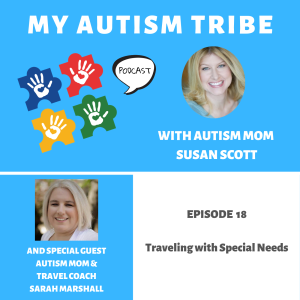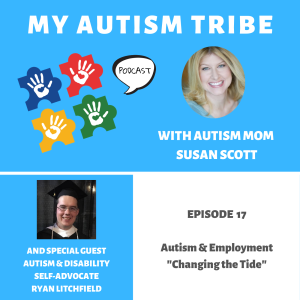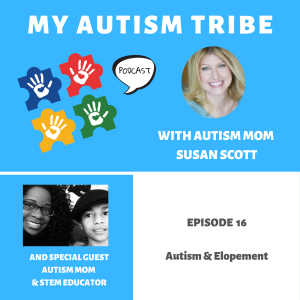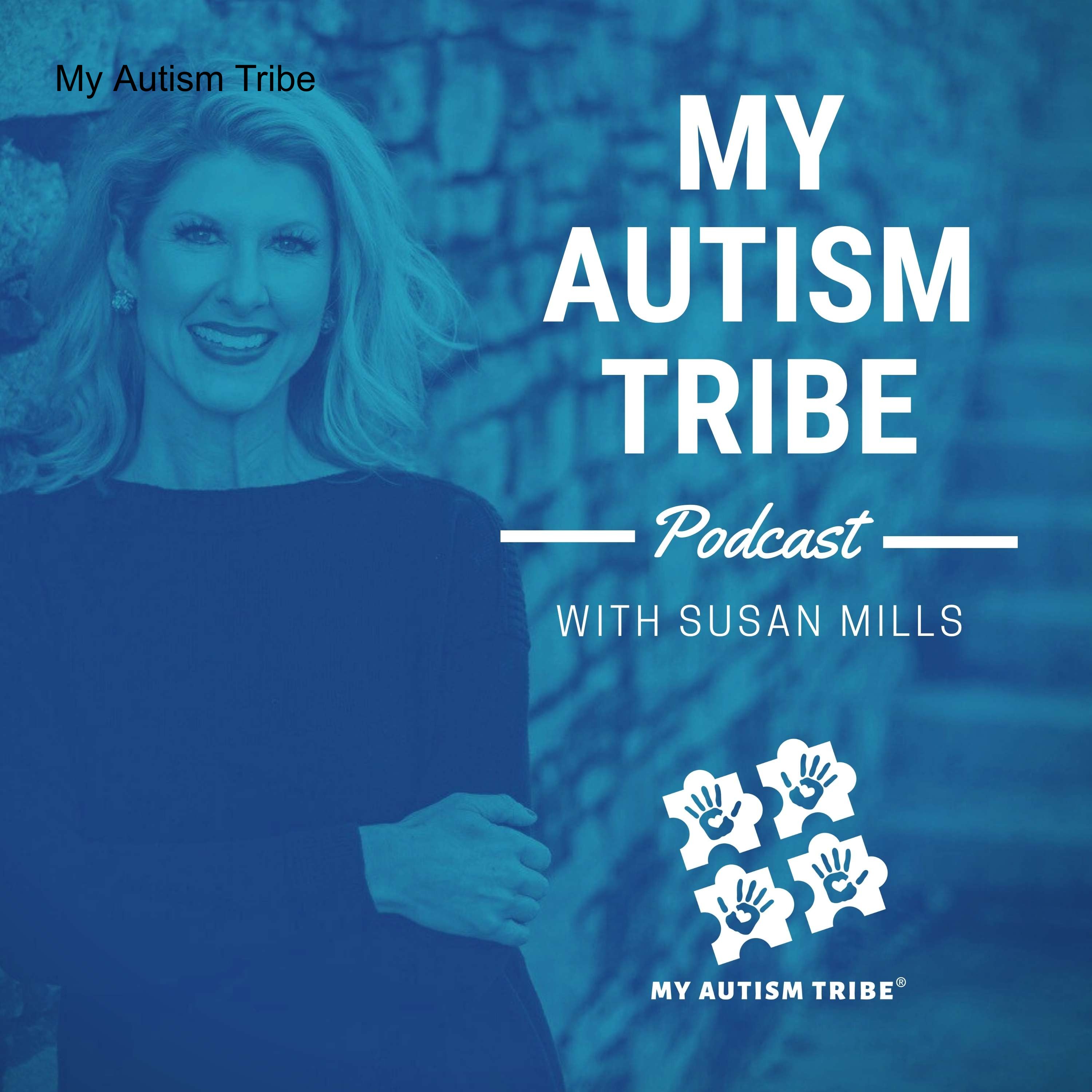Episodes

Monday May 20, 2019
Traveling with Special Needs
Monday May 20, 2019
Monday May 20, 2019
EPISODE 18:
Traveling with children of any age can be difficult at times, can we agree? Traveling with someone who has special needs can add additional challenges to the regular stresses of travel. So when you combine the two, traveling with a child who has special needs can seem like an impossible task. But, it isn’t impossible. It’s simply a new challenge where the rewards are worth well more than the effort.
Today we’re speaking with autism mom and special needs travel coach, Sarah Marshall. She helps those who dream about a perfect family vacation, but struggle with making that dream come true because of the stressful reality of their child’s unique situation. Sarah takes her first-hand experience and professional expertise to find families the unique supports and accommodations to make their vacations a time to heal from stress so they can focus on making lifetime memories.
CONCLUSION
For our loved ones on the autism spectrum, traveling with unfamiliar routines and encountering stressful situations can be really hard, but you can show them that traveling can be a great adventure. Some helpful tips to consider may be:
- Consider the “musts” when you travel. Is there a specific food, toy, or routine that your child MUST have.
- Use social stories before you travel to help them prepare. Even finding YouTube videos on where you’re going can help.
- Prepare activity kits
- Bring an emergency bag and medical information
- And slow down, incorporate “breaks” for the whole family when traveling. It will help them and you to enjoy the moment.
Thanks for listening and being a part of My Autism Tribe. I’ll see you next week!
Sarah Marshall info
https://www.facebook.com/travelablevacations/
Phone: 630-445-1144
Scheduler: calendly.com/travelablevacations
Email:info@travelablevacations.com
ANOTHER RESOURCE:

Tuesday May 14, 2019
Autism & Employment
Tuesday May 14, 2019
Tuesday May 14, 2019
EPISODE 17:
With Autism & Disability Self-Advocate Ryan Litchfield: Educational, Personal, and Professional Experiences in Working with the Autism and Gerontological Communities
INTRO:
For people with autism, it can be tough to find regular, paid employment. Times are changing for the better, however, there is much work to be done for advancement.
Only until fairly recently have Transition-to-Adult Programs been established, and they are in infancy. Some adults with autism have no intellectual disability, but are coping with severe anxiety, and others may have amazing technical skills but experience sensory challenges.
Schools are mandated to provide appropriate transition programs for autistic students, but not all schools are ready or able to do so, and adults services vary by location.
On today’s episode, we’re speaking with Ryan Litchfield; an autism and disability self-advocate with educational, personal, and professional experiences in working with the autism and gerontological communities. He has over 7 years of public speaking on disability and health advocacy across many communities within central Massachusetts, and is passionate in helping individuals with autism to work on and pursue their personal and professional goals.
CONCLUSION:
One of the first big corporations to recruit individuals with autism was Microsoft which started its “Inclusive Hiring for People with Disabilities” program three years ago in the US. Each candidate hired by Microsoft has access to a third-party job coach who helps them transition into the workforce and answers any questions they may have. Their mission is to empower everyone in the organization, and to create a diverse workforce.
If you are an employer, here are some tips:
- Check whether your job description is relevant to the job
- For application forms, it’s not always obvious what information the applicant needs to provide on the application form. It’s important to provide clear guidance on this and to make sure the form includes a space for applicants to highlight any help or adjustments they want at an interview
- During the interview stage, make sure that the questions you ask are clear and unambiguous.
If you’d like additional information, please feel free to reach out to My Autism Tribe, and if you’d like to hear firsthand from someone’s experiences, reach out to Ryan at www.ryansvoice.blog .
Thanks so much for listening to My Autism Tribe, and I’ll see you next week!

Monday May 06, 2019
Autism & Elopement
Monday May 06, 2019
Monday May 06, 2019
EPISODE 16:
Eloping is an all too common problem among children with autism, so much so that the phenomenon has been on the radar of the CDC for years. It’s described as the urge to leave protected and safe surroundings, such as a home or school, without notifying anyone. It’s also known as wandering, running or bolting.
The two primary reasons that a child may leave their surroundings is to leave a bad situation or to pursue something they want.
If you’ve discovered your child is a runner, you may already be aware of the measure you need to take. If you’re just beginning your autism journey, the idea of your child walking out the door in the middle of the night and vanishing may scare you to death, and you’re not alone.
We’re speaking with Tracey McEntyre today, and she knows firsthand the fear that surrounds elopement. She’s a mother, advocate, friend, STEM educator and business owner. Her most important role is being a mother to her 13-year old son Roman. When her son was diagnosed with autism, they began a new journey of advocacy for Roman, advocating for other families, and reinventing how our children learn.
CONCLUSION:
The CDC offers some helpful tips that can help you prepare in advance in the event that your child bolts:
- Set up an emergency response plan
- Keep a current photo of your child
- Have your child wear an ID bracelet
- Let anyone who may have regular contact with your child know they may wander
- Meet your neighbors and inform them of your situation
- Immediately call first responders
- Teach your child safety commands such as “stop”
- Teach your child to swim
- Teach them how to cross a street
- Meet with any healthcare providers who understand your child’s unique situation and ask for their expert advice
There isn’t any way to ensure 100% that your child is safe in this world. This just isn’t something that is possible for any parent, but with establishing proper safety measures, it will help to alleviate some of the fears that come with the possibility of facing this situation.
For more information you can visit the CDC and Autism Society websites, and of course, as always, please feel free to reach out to My Autism Tribe. Thanks so much for listening and I’ll see you next week.
IMPORTANT RESOURCES:
https://www.cdc.gov/ncbddd/disabilityandsafety/wandering.html

